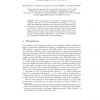Free Online Productivity Tools
i2Speak
i2Symbol
i2OCR
iTex2Img
iWeb2Print
iWeb2Shot
i2Type
iPdf2Split
iPdf2Merge
i2Bopomofo
i2Arabic
i2Style
i2Image
i2PDF
iLatex2Rtf
Sci2ools
ESA
2006
Springer
2006
Springer
Reporting Flock Patterns
Data representing moving objects is rapidly getting more available, especially in the area of wildlife GPS tracking. It is a central belief that information is hidden in large data sets in the form of interesting patterns. One of the most common spatio-temporal patterns sought after is flocks. A flock is a large enough subset of objects moving along paths close to each other for a certain pre-defined time. We give a new definition that we argue is more realistic than the previous ones, and we present fast approximation algorithms to report flocks. The algorithms are analysed both theoretically and experimentally.
Algorithms | Certain Pre-defined Time | Common Spatio-temporal Patterns | ESA 2006 | Large Data Sets |
| Added | 22 Aug 2010 |
| Updated | 22 Aug 2010 |
| Type | Conference |
| Year | 2006 |
| Where | ESA |
| Authors | Marc Benkert, Joachim Gudmundsson, Florian Hübner, Thomas Wolle |
Comments (0)

